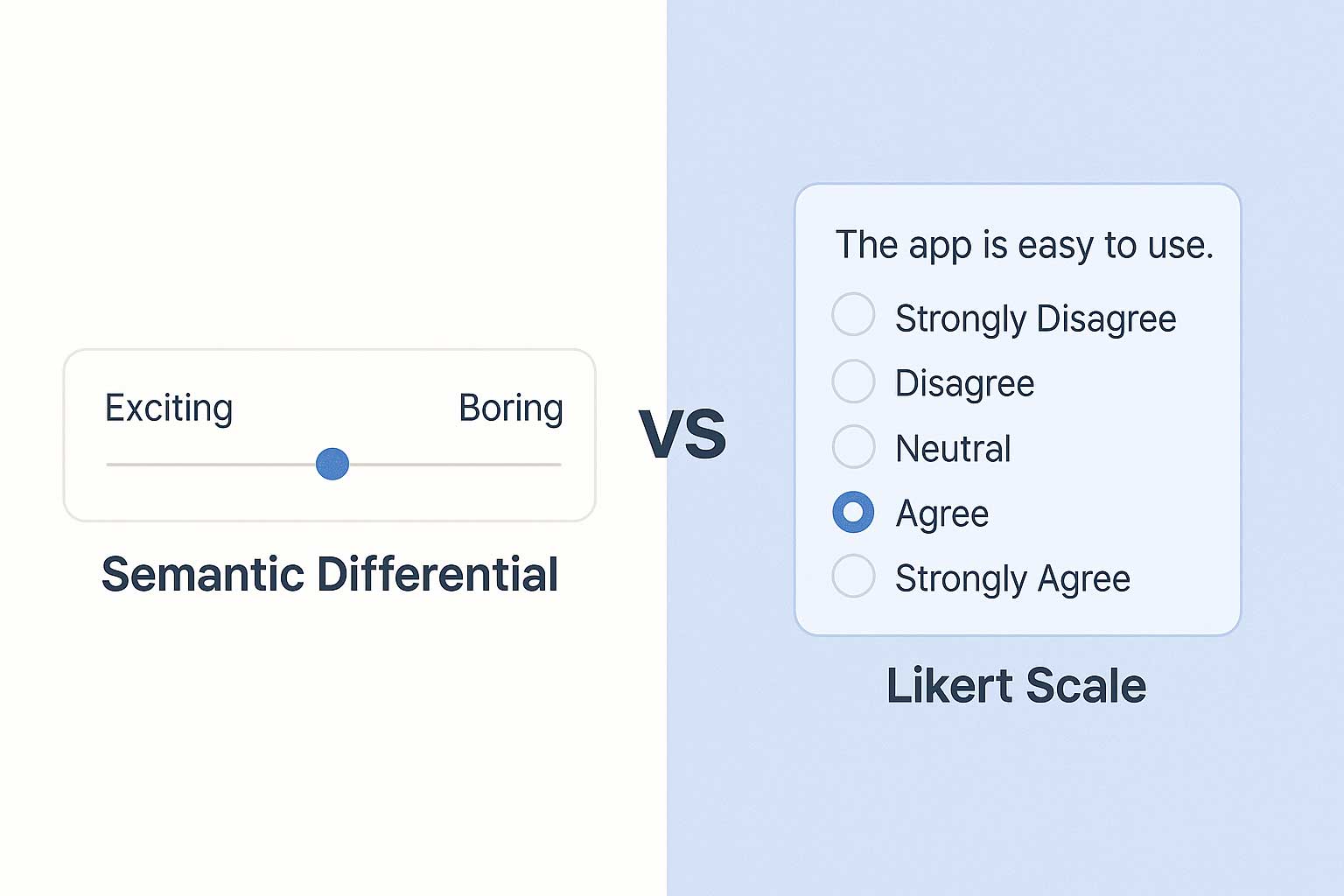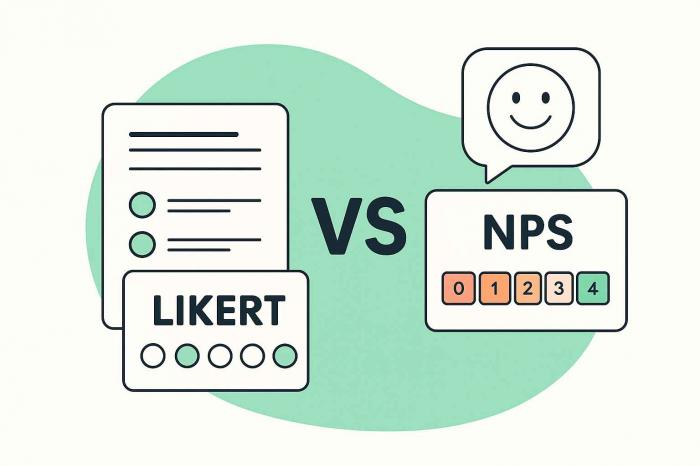When to use a Semantic Differential Scale over a Likert Scale
 When you're building a survey, there's a crucial question you have to answer before you even type the first word: How should I ask? Most people focus on what to ask, but in reality, the format of your questions plays just as big a role in the kind of feedback you’ll get. Imagine trying to measure someone’s feelings about a product or a brand — a simple “yes” or “no” won’t cut it. That’s where different question types come in, and two of the most powerful tools for measuring attitudes and perception are the Semantic Differential Scale and the Likert Scale.
When you're building a survey, there's a crucial question you have to answer before you even type the first word: How should I ask? Most people focus on what to ask, but in reality, the format of your questions plays just as big a role in the kind of feedback you’ll get. Imagine trying to measure someone’s feelings about a product or a brand — a simple “yes” or “no” won’t cut it. That’s where different question types come in, and two of the most powerful tools for measuring attitudes and perception are the Semantic Differential Scale and the Likert Scale.
They may seem similar at a glance — both involve rating something on a scale — but they serve different purposes and capture entirely different dimensions of feedback. In this article, we’ll break down how the Semantic Differential Scale works, how it differs from the more familiar Likert scale, explore the main types of semantic scales, and explain when to use it to get the most out of your surveys.
How Semantic Differential Scale Works
A Semantic Differential Scale is a type of survey question that asks respondents to rate something between two opposing adjectives. Instead of asking whether someone agrees with a statement, it asks them to judge a concept, product, or experience on a continuum. For example, rather than saying “I found the app easy to use” and letting someone choose “agree” or “disagree,” a semantic differential scale might ask: “How would you rate the app?” with a scale that runs from Easy to Difficult. Respondents then choose the point on the line that best represents their feeling.
This method was developed by psychologist Charles E. Osgood in the 1950s to help measure people's emotional and psychological responses to words and concepts. It works beautifully in modern surveys because it lets you tap into how people feel rather than what they think. It’s ideal for exploring impressions, brand identity, or emotional tone.
One of the great strengths of the semantic differential scale is how intuitive it feels to users. The layout — often a horizontal line with words like “Clean” on one side and “Dirty” on the other — mirrors how we think in opposites. People instinctively know how to place their feelings somewhere along that spectrum, especially when the language is clear and relevant to the subject at hand.
Another benefit is the richness of the data. With just a few carefully selected bipolar adjective pairs, you can capture subtle shades of perception that a simple agree/disagree scale might miss. It’s also visually engaging, which encourages better completion rates. However, this strength can also become a weakness if the adjectives are too vague, too similar, or not truly opposites. When done poorly, semantic scales can confuse respondents or lead to inconsistent answers. That’s why clarity in wording is critical.
While semantic differential scales are great for measuring feelings and perceptions, they’re less effective at capturing factual data or opinions about frequency or agreement. You wouldn’t use them to ask how often someone uses your product — for that, a different scale would be more appropriate. But if you want to know how they perceive your product — as trustworthy or untrustworthy, powerful or weak, professional or unprofessional — then this scale gives you a clear window into their mindset.
Semantic Differential Scale vs Likert Scale
Although both the semantic differential and Likert scale are used to measure attitudes, they differ in structure, focus, and usage. A Likert scale typically presents a statement — like “The customer service was helpful” — and asks the respondent to indicate how much they agree or disagree, often on a 5-point or 7-point scale ranging from “Strongly Disagree” to “Strongly Agree.”
In contrast, semantic differential scales present two opposite adjectives and ask respondents to choose a point between them. For example, instead of a statement like “The product is reliable,” a semantic question would show a line between “Reliable” and “Unreliable” and ask users to place a mark where they feel the product lies.
The key distinction is that Likert scales measure agreement with a given statement, which is more cognitive and logical in nature. Semantic differential scales measure perception or emotional response, which can be more instinctive and subjective.
Because of this, Likert scales are great for understanding beliefs, opinions, and satisfaction levels. They’re ideal for HR surveys, customer satisfaction studies, and educational assessments where respondents need to react to clearly stated claims. Semantic differential scales, on the other hand, are better suited for branding, design feedback, emotional engagement, or product experience — any situation where you're trying to understand how people feel rather than what they believe.
Another subtle difference is in how the data can be analyzed. Likert scales often lead to averages and percentage breakdowns by response group. Semantic differential responses can be visualized using spider charts or perceptual maps, giving a visual representation of brand or product positioning across various attributes.
Types of Semantic Differential Scales
There isn’t a one-size-fits-all format for semantic scales. Depending on the context and what you're measuring, there are different ways to build and display them. Here are five key types:
1. Classic Bipolar Scale
This is the most common version. It features two clearly opposite adjectives (e.g., Clean – Dirty, Expensive – Cheap) placed at either end of a horizontal or vertical line. Respondents choose a position along the line to indicate their feeling. It’s direct, easy to understand, and great for measuring extremes and everything in between.
2. Numeric Semantic Scale
In this version, each point on the scale is assigned a numerical value — for example, 1 to 7 or -3 to +3. This doesn’t change the user experience much but helps researchers analyze the data more easily, especially when calculating averages or correlations. It’s helpful in advanced statistical modeling where numerical values are needed.
3. Graphical Semantic Scale
Instead of numbers or lines, this format uses symbols or visuals like smiley faces, sliders, or emoticons to represent the range of emotions. This version is especially effective in mobile surveys or with audiences who may have lower literacy levels. It’s also widely used in UX research and child-based studies because of its intuitive appeal.
4. Customized Semantic Scale
This type allows you to tailor the adjective pairs to suit a particular industry or context. For instance, a food delivery app might use Fresh – Stale, Fast – Slow, or Affordable – Pricey. These are not generic opposites, but adjectives that matter specifically to your target audience and their experience. Custom semantic scales give you flexibility to explore the emotional core of a brand or product in your own language.
5. Multidimensional Semantic Scale
Here, multiple semantic differential questions are grouped to assess different aspects of a single concept. For example, to evaluate brand perception, you might ask users to rate it across five pairs: Modern – Old-fashioned, Fun – Boring, Trustworthy – Unreliable, Simple – Complicated, and Friendly – Distant. This creates a well-rounded picture of how the brand is perceived across several dimensions and works well for creating perceptual maps or dashboards.
When to Use a Semantic Differential Scale
Semantic differential scales are best used when you want to uncover how people truly feel about a product, service, brand, or concept — especially when those feelings are complex or emotional in nature. They’re particularly useful in marketing and branding surveys where perceptions matter more than facts. For example, if you’re trying to understand how your new logo is received, or what impression your website leaves on visitors, semantic scales can highlight subtle emotional responses that would be hard to capture with standard agreement statements.
They’re also valuable in UX surveys, where users can rate an app or feature using scales like Intuitive – Confusing or Responsive – Slow. This kind of feedback helps designers and developers prioritize improvements based on how users emotionally interact with a product.
In post-event surveys, you can use semantic scales to measure how attendees perceived the tone, professionalism, or overall feel of the event. And in product development, you can assess how early prototypes are being received emotionally, before people even form concrete opinions.
Whenever you’re dealing with branding, design, emotion, or perception, semantic differential scales are often the best option in your survey toolbox.
Final Thoughts
The Semantic Differential Scale isn’t just another question type — it’s a window into how people feel, not just what they think. It offers depth, emotional clarity, and a way to visualize perceptions that other question types can’t provide. When compared to Likert scales, it becomes clear that each has its place. Likert scales are excellent for measuring beliefs and agreement. Semantic scales shine when exploring impressions, experiences, and feelings.
At Enquete, we’ve made it easy to create both types of scales using our intuitive survey builder. Whether you're trying to map out your brand’s emotional profile or gauge agreement with a new policy, our platform helps you craft questions that reveal the truth behind the answers.


